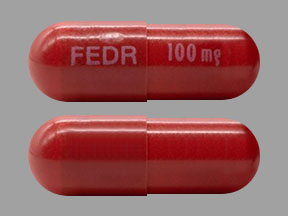Inrebic and Alcohol/Food Interactions
There is 1 alcohol/food/lifestyle interaction with Inrebic (fedratinib).
Fedratinib Food/Lifestyle
Moderate Food Interaction
GENERALLY AVOID: Grapefruit juice may increase the plasma concentrations of fedratinib. The proposed mechanism is inhibition of CYP450 3A4-mediated first-pass metabolism in the gut wall by certain compounds present in grapefruit. Inhibition of hepatic CYP450 3A4 may also contribute. The interaction has not been studied with grapefruit juice, but has been reported for other CYP450 3A4 inhibitors. When a single 300 mg oral dose of fedratinib (0.75 times the recommended dose) was coadministered with 200 mg twice daily ketoconazole, a potent CYP450 3A4 inhibitor, fedratinib total systemic exposure (AUC(inf)) increased by approximately 3-fold. Using physiologically based pharmacokinetic (PBPK) simulations, coadministration of fedratinib 400 mg once daily and ketoconazole 400 mg once daily is predicted to increase fedratinib AUC at steady state by 2-fold. Coadministration with the moderate CYP450 3A4 inhibitors, erythromycin (500 mg three times daily) or diltiazem (120 mg twice daily), is predicted to increase fedratinib AUC by approximately 1.5- to 2-fold following single-dose administration and by approximately 1.2-fold at steady state. In general, the effect of grapefruit juice is concentration-, dose- and preparation-dependent, and can vary widely among brands. Certain preparations of grapefruit juice (e.g., high dose, double strength) have sometimes demonstrated potent inhibition of CYP450 3A4, while other preparations (e.g., low dose, single strength) have typically demonstrated moderate inhibition. Increased fedratinib exposure may potentiate the risk of adverse reactions such as nausea, vomiting, diarrhea, anemia, thrombocytopenia, neutropenia, encephalopathy (including Wernicke's), liver (ALT, AST) and pancreatic (amylase, lipase) enzyme elevations, increased blood creatinine, and secondary malignancies.
Food does not affect the oral bioavailability of fedratinib to a clinically significant extent. Administration of a single 500 mg dose (1.25 times the recommended dose) with a low-fat, low-calorie meal (162 calories; 6% from fat, 78% from carbohydrate, 16% from protein) or a high-fat, high-calorie meal (815 calories; 52% from fat, 33% from carbohydrate, 15% from protein) increased fedratinib peak plasma concentration (Cmax) and systemic exposure (AUC) by up to 14% and 24%, respectively.
MANAGEMENT: Fedratinib may be taken with or without food. However, administration with a high-fat meal may help reduce the incidence of nausea and vomiting. Patients should avoid consumption of grapefruit and grapefruit juice during treatment with fedratinib.
References (3)
- Wu F, Krishna G, Surapaneni S (2020) "Physiologically based pharmacokinetic modeling to assess metabolic drug-drug interaction risks and inform the drug label for fedratinib." Cancer Chemother Pharmacol, 86, p. 461-73
- (2022) "Product Information. Inrebic (fedratinib)." Bristol-Myers Squibb
- (2021) "Product Information. Inrebic (fedratinib)." Bristol-Myers Squibb Pharmaceuticals Ltd
Switch to consumer interaction data
Inrebic drug interactions
There are 570 drug interactions with Inrebic (fedratinib).
Inrebic disease interactions
There are 9 disease interactions with Inrebic (fedratinib) which include:
- severe hepatic impairment
- thiamine deficiency
- Fedratinib-gastrointestinal toxicity
- cardiovascular risk
- malignancy
- thrombosis
- renal impairment
- Fedratinib-cytopenias
- Fedratinib-pancreatitis
More about Inrebic (fedratinib)
- Inrebic consumer information
- Check interactions
- Compare alternatives
- Pricing & coupons
- Drug images
- Side effects
- Dosage information
- During pregnancy
- FDA approval history
- Drug class: multikinase inhibitors
- Breastfeeding
- En español
Related treatment guides
Drug Interaction Classification
| Highly clinically significant. Avoid combinations; the risk of the interaction outweighs the benefit. | |
| Moderately clinically significant. Usually avoid combinations; use it only under special circumstances. | |
| Minimally clinically significant. Minimize risk; assess risk and consider an alternative drug, take steps to circumvent the interaction risk and/or institute a monitoring plan. | |
| No interaction information available. |
See also:
Further information
Always consult your healthcare provider to ensure the information displayed on this page applies to your personal circumstances.


